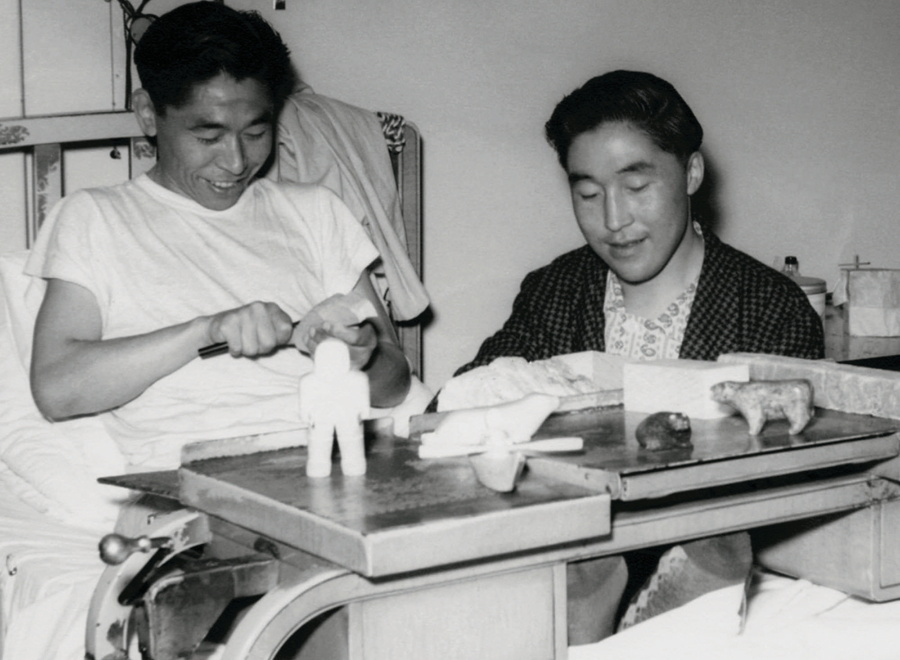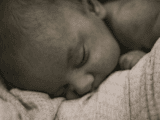Rosie Simonfalvy and her sister Annie Nattaq almost collapsed with emotion last Thanksgiving Sunday outside the United church in the Mohawk community of Kahnawake, Que. After waiting five decades and travelling thousands of kilometres, they were finally just a short walk from the burial site of their sister, Mary Unga. They knocked on the front door, and when no one answered, Simonfalvy felt her entire body become heavy. Not realizing there was a service going on inside, she hurried to the side door and continued knocking until church member Allan Patton answered and volunteered to show the two women to a patch of small gravestones in the corner of a nearby cemetery.
On that beautiful October morning, a babbling creek was the only sound in the otherwise tranquil grounds. Simonfalvy and Nattaq went about clearing leaves and grass from the headstones so they could read the inscriptions that Patton’s grandfather had scratched with his finger back when he was the cemetery’s caregiver.
You may unsubscribe from any of our newsletters at any time.
When the women finally found their sister’s name, they cried. “To be able to see the grave and touch the stone after so many years — that was very special,” says Simonfalvy. “It wasn’t a closure, exactly, but I have a more peaceful heart now.”
Mary Unga died from tuberculosis on April 7, 1958, at the age of 19. Her Baffin Island family was never told exactly where she had been laid to rest. They assumed it must have been near the hospital where Unga had been treated in Hamilton. But when Simonfalvy visited the southern Ontario city a few years ago, she couldn’t find any trace of her.
Simonfalvy’s family was one of many who lost track of loved ones after tuberculosis swept Canada’s Arctic regions in the 1950s. Thousands of sick people went south for treatment, and many of those who died were buried in southern graves without their relatives’ knowledge. But since September, a monument in Kahnawake has proclaimed the names of the Inuit who wound up in the town’s Protestant cemetery.
“Prayers were said over them,” says Arlene Delaronde, a retired social worker from the community. “And now their families will know where they are.”
The Kahnawake monument is the latest development in a long and tragic story. Pat Grygier, the author of the most comprehensive history of the 1950s tuberculosis outbreak, describes how the bacterial lung disease, after having been introduced to the North by people of European descent, gradually reached epidemic proportions among the Inuit, who had no immunological resistance to it.
“At least one third of the Inuit population . . . was infected with TB,” she writes. “In some communities, virtually everyone was infected at one time or another.”
The federal government responded to this crisis by sending coast guard ships to the North to X-ray everyone. Those who tested positive for TB were brought south for quarantine and treatment at sanatoriums. Located in cities such as Hamilton, Quebec City and Montreal, these specialized hospitals provided the best TB treatment know nat the time.
But “very little, if any, attention was paid to the effect of this separation on either the patients or their families,” says Grygier. Some of the patients she interviewed remembered being forbidden to go ashore from the medical ships to say goodbye to their families. This was in spite of the fact that the average stay in a sanatorium was two and a half years.
“It all happened so fast, I scarcely had time to think,” writes Leah Idlout d’Argencourt in the compilation Northern Voices: Inuit Writing in English. D’Argencourt was a young child living near Pond Inlet on Baffin Island, Nunavut, when she contracted TB. “By the time we all arrived back on the ship, I knew for sure that it was true, that I was really going, although I was totally unprepared and didn’t even have any baggage to take along. I didn’t feel sick. Was I going to die in the hospital? Was I going away for good? . . . It terrified me to think of these things.”
The lack of concern for TB patients’ personal lives didn’t stop with whisking them away before they had time to make arrangements. When patients died, the Department of Northern Affairs was supposed to make sure their families were notified, but government record keeping was often disorganized, so many people never learned the fate of their relatives.
Rev. Maureen Scott Kabwe, the minister of Kahnawake United, says that when she first learned about the handling of the Inuit TB outbreak, she noticed some parallels with the Indian residential school system. “I just find it so typical of the mindset of the time,” she says. “There was a lack of respect for the integrity of people’s families.”
At least 16 Inuit patients were laid to rest in Kahnawake United’s cemetery. They had travelled to Montreal to be treated for TB and other illnesses. The reason they wound up on the nearby Mohawk reserve is likely because the federal government’s local Indian agent was put in charge of their burials.
Each year, the congregation of Kahnawake United holds a service at the cemetery in memory of parishioners who have died. “A few years ago, people started talking about the Inuit at these services,” Scott Kabwe says. “Some of them could recall their funeral services. It became obvious that they cared about these people — it was something that had been affecting them for a long time.”
“Here in Kahnawake, we are very close, and when there’s a death, the community feels it,” says Doris Montour, an elder and a member of the church’s Board. “So I think it’s sad that [the Inuit] are here and their families have no idea where they are. How awful it must be.”
That’s why the Board was very receptive when Delaronde suggested the church commemorate the deceased Inuit with a monument. Scott Kabwe prepared by digging through old handwritten church records to find out all she could about the 16 individuals named on the headstones. Meanwhile, Patton collected flat stones from the St. Lawrence River for two small Inukshuks to mark the boundaries of the burial space.
Finally, the congregation consecrated a simple gravestone-shaped monument last September in the presence of a few dozen onlookers. It reads, “In loving memory of our Inuit brothers and sisters buried here 1950-1959. May they rest in peace.”
Scott Kabwe sees the monument as part of the church’s attempt to live in right relations. “We just wanted to do something to show some respect,” she says. “Canadians as a whole need to atone for history. There’s so much grief that people are still carrying and that needs to be healed.”
Kahnawake United’s gesture didn’t go unnoticed. Before long, a story about the monument appeared in the Nunatsiaq News, a Nunavut regional newspaper. One of Rosie Simonfalvy’s co-workers showed her Mary Unga’s name in the article, thereby setting Simonfalvy’s emotional trip to Kahnawake in motion.
News of the monument was also read with interest by Alec Gordon, a radio journalist in Kuujjuaq, Que., whose infant sister was buried in Kahnawake. Gordon already knew she was there because his mother had accompanied her to Montreal for treatment. “But my mother was only informed after she died that she had already been brought to a burial site,” he says. The family would have preferred to bury her closer to home. “We are so far away, you know. We can’t go down there often because the travel is so expensive.”
Both Simonfalvy and Gordon are grateful to the church people and elders in Kahnawake. “We are happy our relatives haven’t been forgotten — even by people who didn’t know them,” says Gordon. “To have people looking after their resting place is an honour for us.”
***
This story first appeared in The United Church Observer’s March 2011 issue with the title “A forgotten injustice.”













